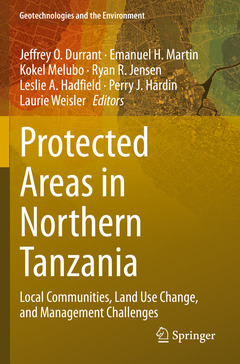Protected Areas in Northern Tanzania, 1st ed. 2020 Local Communities, Land Use Change, and Management Challenges Geotechnologies and the Environment Series, Vol. 22
Coordonnateurs : Durrant Jeffrey O., Martin Emanuel H., Melubo Kokel, Jensen Ryan R., Hadfield Leslie A., Hardin Perry J., Weisler Laurie

Northern Tanzania is an important and diverse ecological and cultural region with many protected lands. This book, Protected Areas in Northern Tanzania, brings to the forefront research on significant issues and developments in conservation and management in national parks and protected lands in northern Tanzania. The book draws attention to issues at the intersection of conservation, tourism, and community livelihood, and several studies use geospatial technologies?Geographic Information Systems and remote sensing data and techniques?to study land use and land cover conversion. With contributions from professors at the Mweka College of African Wildlife Management located at the foot of Mount Kilimanjaro and other Tanzanian researchers, the book provides important perspectives of local experts and practitioners. Protected Areas in Northern Tanzania provides a significant contribution in research and technological advancement in the areas of wildlife conservation and protected land management throughout this critical region.
Chapter 1: “Protected Areas in Northern Tanzania: An Introduction”
Jeffrey O. Durrant, Leslie Hadfield, Emanuel Martin, Perry Hardin, Ryan Jensen
SECTION I: “Communities and Management Challenges”
Edited by: Jeffrey O. Durrant and Leslie Hadfield
Chapter 2: “A Geography of Protected Areas”
Jeffrey O. Durrant, Brigham Young University
Chapter 3: “Conservation Governance in Northern Tanzania: Implications for Conservation and Community Livelihood”
Alex Kisingo, Mweka College of African Wildlife Management
Chapter 4: “Wilderness Skills Offering to Students”
Kokel Melubo, Mweka College of African Wildlife Management
Chapter 5: “Hunting in Tanzania: Opportunities and Challenges”
Henry Njovu, Mweka College of African Wildlife Management
Chapter 6: “Tourism Supply System”
Masuruli Baker, Mweka College of African Wildlife Management
Chapter 7: “Response of Cavity Breeding Birds on Shortage of Deadwood Outside Protected Areas”
Hamadi I. Dulle, Mweka College of African Wildlife Management
Chapter 8: “Historical Change in Porter Work on Kilimanjaro”
Leslie Hadfield, Brigham Young University
SECTION II: Geospatial Technologies, Land Cover, and Conservation in Northern Tanzania
Edited by: Emanuel Martin, Ryan Jensen, and Perry Hardin
Chapter 9: “Land Cover Change in the Kwakuchinga Wildlife Corridor”
Emanuel Martin, Mweka College of African Wildlife Management, Perry Hardin, and Ryan Jensen, Brigham Young University
Chapter 10: “Mkomazi National Park Vegetation Dynamics”
Glory Sumaye and Emanuel Stephen, Tanzanian National Parks (TANAPA), Emanuel Martin, Mweka College of African Wildlife Management.
Chapter 11: “Spatiotemporal Patterns of Giraffe Poaching Around Arusha National Park”
Philipo Malley, Fredrick Malisa, Mweka College of African Wildlife Management, Ryan Jensen, Brigham Young University
Chapter 12: “Community Forestry in Northern Tanzania”
Neema Kinabo, Mweka College of African Wildlife Management
Chapter 13: “Illegal Logging in Arusha National Park”
Philipo Malley, Mweka College of African Wildlife Management
Chapter 14: “Protected Areas in Northern Tanzania: The Way Forward”
Jeffrey Durrant, Leslie Hadfield, Emanuel Martin, Perry Hardin, Ryan Jensen
Jeffery Durrant (Ph.D., University of Hawaii) is an Associate Professor of Geography at Brigham Young University. Durrant primarily studies public lands and protected areas. His research interests include motorcycle studies, art, and Africa.
Leslie Hadfield (Ph.D., Michigan State University) is an Associate Professor of History and the Africana Studies Coordinator at Brigham Young University. Hadfield primarily studies South African contemporary social and political history. Her research interests include South African liberation movements and the experience of black nurses in the Eastern Cape. Oral history is an important part of her work.
Perry Hardin (Ph.D., University of Utah) is a Professor of Geography at Brigham Young University. Hardin primarily studies culture and geography of Africa and Central Asia with expertise in remote sensing, Geographic Information Systems, and geographic methods. His research interests include remote sensing of urban areas and land cover change.
Ryan Jensen (Ph.D., University of Florida) is a Professor of Geography at Brigham Young University. Jensen primarily studies biogeography and landscape ecology with expertise in remote sensing and Geographic Information Systems. His research interests include land cover change and carbon dynamics.
Emanuel Martin (Ph.D., Sokoine University of Agriculture) is Lecturer and Head of Research, Consultancy, and Post Graduate Studies at the College of African Wildlife Management. Martin has expertise in wildlife management and wildlife policy. His research interests include forest mammal ecology and modelling, and protected areas planning and management.
Kokel Melubo (Ph.D., University of Otago) is a Senior Lecturer at the College of African Wildlife Management. Melubo is actively involved in student field training and lecturing at CAWM as well as a US
Research and perspective from local experts and practitioners
Provides information on national parks and protected areas
Gives examples of cutting-edge use of remote sensing and other geospatial technologies in conservation
Date de parution : 05-2021
Ouvrage de 179 p.
15.5x23.5 cm
Disponible chez l'éditeur (délai d'approvisionnement : 15 jours).
Prix indicatif 105,49 €
Ajouter au panierDate de parution : 05-2020
Ouvrage de 179 p.
15.5x23.5 cm
Disponible chez l'éditeur (délai d'approvisionnement : 15 jours).
Prix indicatif 105,49 €
Ajouter au panier


